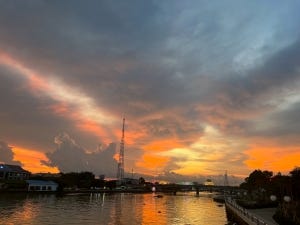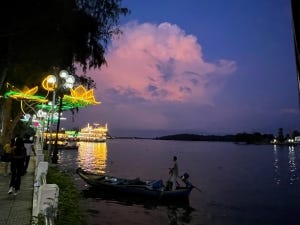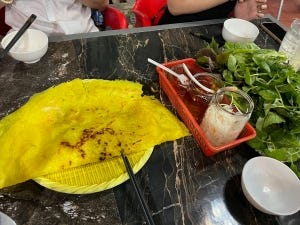Snapshots from another sinking city
My room on the 9th floor of the Sheraton had a view out across Sông Cần Thơ River that runs along south side of the city of Cần Thơ. After a morning at Cần Thơ University listening to students’ proposals to build climate change resilience, my brain felt tired but inspired. Foremost on my mind was this: What is it that gives you hope when your world is sinking? How do you plan for a future that might be underwater?
It felt a bit awkward for me to be at ‘ground zero’ for climate change and sit in a high-rise Sheraton. Yet here I was, in a building that encompasses the global consumer culture responsible for climate change, watching incipient thunderclouds skirt across the flat green horizon, knowing that nearly everything within my view could be underwater in 25 years. (To their credit, Marriott International, Inc., which owns Sheraton, has committed to going carbon-free by 2050. But that seems SO far away.)
Cần Thơ is a city of about 1.8 million people (as of 2023) in the heart of the Mekong Delta. A large part of the city sits on landfill, and I’m reminded of Venice or the Marina District in San Francisco. These places were once marshes and are now home to thousands of people. Here in Cần Thơ, waterways and mangrove swamps line vibrant city streets, and a promenade with shops and floating restaurants along the river lights up at night in every color of the rainbow. The city sits in the midst of Vietnam’s largest rice-growing region, and has one of the largest universities in the country. It’s located inland, roughly 55 miles from the ocean, and like every other city at sea level, it’s sinking.
At the moment this sinking is due to groundwater extraction and rapid growth of the city. But rising sea level already impacting the region through salt-water intrusion. This is what happens first as sea level rises and the fresh water table becomes saturated with salt. This renders farming impossible. And it’s slowly choking one of Vietnam’s largest agricultural regions. Rates of saltwater intrusion have been accelerating since early 2020. Normally, the delta water becomes salty for a short time during the dry season. But the salt is flushed out when the rainy season begins. However, prolonged drought and shifts in rainfall patterns can change the duration of the dry season. We are not going to prevent this, unfortunately. It is already happening and it is inevitable, whether the world warms by 1.5C or 4C in the remainder of this century.
This same thing is happening in my home state of California, and the state is building a $30 million dollar wall to stop the salt from entering the Sacramento-San Joaquin River Delta. Most places in the world don’t have the money, or such ideal geography, for building such a wall.
I watched from my hotel room as swallows darted around outside my window and a barge full of sand, sitting low in the water, plowed it’s way upstream. I thought about how different this view will look in 20 or 30 years, and I felt terrified for the people who live in and depend on agriculture in these low-lying regions.
I also know that I’m part of the problem. Actually, I’m inextricably wrapped up in the problem. As with most of you reading this blog, I have led a privileged life that benefits from the extraction and exploitation of fossil fuels and other resources. And I felt the guilt creep up on me as I sat in a cushy armchair on the ninth floor with the AC blasting to keep the air temperature and humidity at a tolerable level.
But I know my work means something, and I hope that, somehow, some way, I will help other people make a difference in mitigating and adapting to the changes we’re experiencing. It’s hard to keep up that hope when, day after day, you read articles about the losses due to climate change – losses we have already suffered, losses we are in the midst of enduring (thinking of Lahaina), and those on the immediate horizon. But what keeps me going are my interactions with students.
I think about the students I talked with at Cần Thơ University. I was only there for three days, but I got to spend a lot of time with some of the students who are most concerned about climate change. I was so struck by how earnest they are about making a difference, and how they are learning what it might mean to make a long-term impact. They are designing projects to build climate resilience, and as part of that activity, they are asked to consider how they can have a lasting impact. The students come from all majors. There are the English speaking students who want to help other students feel confident speaking up about climate change. There are students hoping to clean up a local lake with some high school students and teach them about sustainability. There’s a team that is trying to understand the impact of the urban heat island on mental and physical health. Another team has created a music contest for high school students to promote the use of paper for milk tea over single use plastics.
The students are each learning to work as an integral part of a team – something we all need to learn how to do better. Maybe it starts by having fun together. At the start of our meeting, we all stood in a circle and rubbed our hands together, then someone, who was selected as our leader, clapped, and we all had to clap at the same time, trying to synchronize with our leader. We all laughed at the thunder of mis-timed claps. I felt honored to be part of their group for a day.
After sharing with me their project proposals for climate resilience, they asked me for feedback. I felt emotional, having seen the earnestness with which they approach these projects, and how much they care. This sincerity one of the things that gives me hope for our future on this planet. This is what makes me think that we will survive as a civilization. I know that our ideas never pan out entirely as planned – but that every one of them has merit. I tell them that their projects will probably turn out different than what they expect, and that it’s not a failure. We all learn by trying – and we need to try everything.
In the evening, a handful of students take me on a walking tour of campus. They are so enthusiastic, and some of them happily practice English with me. A few of them take me out to dinner and introduce me to the local version of Bahn Xeo – an eggy, savory crepe filled with meat and coconut that you wrap in green leaves. I make a big mess, dropping bits of meat and egg all over the table as my hands become slippery with grease and fish sauce. It’s delectable. My dining companions are so much neater than I am. They also give me tour of the promenade along the river, and through the night market. The city lights shimmer on the river water, and the whole place feels electric.
These students seem to have an optimism that I want to harness and save for a rainy day. Or maybe for a blistering hot day. What has given them that confidence? The idea that anything is possible? How can I help my own students build that confidence? I know that when you only visit a place for a short time, you don’t see the hardships – when you only meet people for a few days, you don’t see the doubts. I know they are there. But in the end, when your world is sinking, maybe there is no choice but to have hope.
Maybe Cần Thơ is a sinking city, but there are a lot of young people working to keep it afloat. I think the secret to moving forward is not unwavering optimism, but rather, action and energy. My hope is that every sinking city can have a core of energetic people to help it stay afloat.











